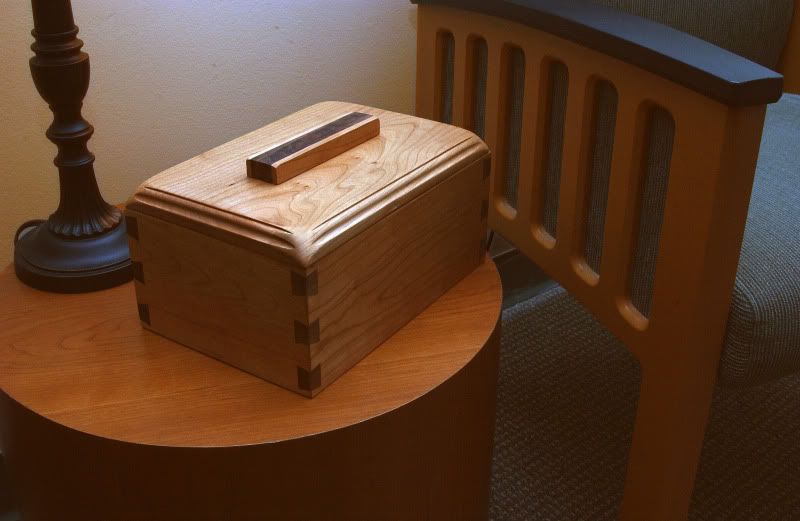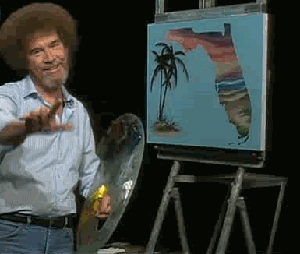Some things that I watch on TV can get me very excited. The recent negative political ads before Election Day made me completely angry and frustrated. A close football or basketball game can get my heart pumping. Watching the nightly news leaves me feeling disgusted many evenings.
But, there are also shows that leave me totally relaxed. On the PBS Create channel, I recently rediscovered a show I hadn’t seen in decades – Bob Ross’ Joy of Painting. I’m no painter, but the late Bob Ross’ voice was exceptionally soothing, and it’s amazing to watch him paint realistic looking landscapes in less than half an hour
The show is airs twice a week here in my market, and I’m even getting my wife and two sons into watching it. Tonight, as Bob painted a serene sunset, I began to think about some of the things he said and what he did, and how I can apply them to woodworking. For instance:
- Bob can paint the majority of his paintings with a 2″ trim paint brush. Tonight, he must have hit 80% of the painting with that brush you or I might use to paint the baseboards. Bob could make that brush do just about anything… How many times do we as woodworkers stop ourselves from trying a new technique because we don’t have the ‘proper’ specialized tool? It took me a long while before I cut my first mortise – using my plunge router – because I believed I had to have a dedicated hollow chisel mortiser. Read up on the tools you already own… you might be surprised what you can do with them.
- “Here’s your bravery test.” Bob said this just after he had completed some gorgeous landscape but before he painted a large looming tree in the foreground. For most of us, when we get the structure of a project built, we tend to complete it with many of the same techniques we are used to. Maybe it’s one particular kind of door pull or finish we’ve used several times with success. Why not put yourself to the bravery test and push beyond what you are comfortable with? Something like an inlay or a hand cut door pull made of a contrasting wood can bump up the style and take your work beyond the expected into the realm of stunning masterpiece – and it will help you grow as a woodworker.
- “Beat the Devil out of it.” Bob would say this as he cleaned one of his brushes before he would work on a new part of the painting. He would swish them in the paint thinner and then rapidly beat them dry on the leg of his easel. He always smiled when he did that. (Bob would also remind his viewers to use odorless paint thinner when cleaning brushes. “If it’s not odorless, you’ll find yourself working alone very, very quick.”). Lately, I have discovered myself dreading the basic shop tasks that we all have to do. Sharpening chisels and plane irons, sweeping the shop, cleaning up stacks of wood. But, when you think about it, aren’t those mundane tasks part of what makes woodworking great? Is there anything more pleasant than paring a joint perfect with a honed chisel or sweeping up the remains of a hard day’s work? You made all of those pretty curls with your own hand plane… and each of those means you have made your project boards that much more ready to be finished. Just like Bob, I’m going to try to take more pleasure in those more routine tasks.
- “We don’t make mistakes, just happy little accidents.” Bob always encouraged his viewers to overcome their fears and just relax in front of the canvas. He realized that many of his viewers would freeze like frightened rabbits, brush in hand, because they believed that every single stroke of paint they laid down had to be perfect. In every episode I’ve seen, he’s always reminded the viewer that if the paint went onto the canvas and didn’t look right, a quick swipe of the palette knife would erase all traces of the mistake and they could start over. In my shop, I often come down hard on myself for miscuts, splintering boards and other miscues. Yet, I’ve been able time and again to either erase the mistake or to simply mill up another piece to replace what went wrong. And, that old woodworker’s adage of “It’s not a mistake, it’s a design feature,” comes into play as well, as many happy little accidents have allowed me to improve the final product.

- The heck with critics. If you do an internet search for Bob Ross, you’ll find plenty of detractors. His work is too simplistic. He’s painting from his imagination, not painting accurate recreations of actual landscapes. He doesn’t paint like ‘The Masters,’ by doing painstaking subject studies and taking weeks to produce his final piece. I call BS. Each artist – each painter – each woodworker – is a person unto his or her own, with their own unique styles, quirks and ways of learning. Feeling you have to spit out authentic reproductions of Shaker tables, Chippendale highboys or Krenov-style cabinets just because someone says that’s the way it’s supposed to be done is ridiculous. Heck, Krenov became famous for breaking from traditional forms to create a unique style of furniture. To stifle creativity in the name of doing things the ‘right’ way is crazy.
Will I ever lay down my saws to pick up the palette? Not sure… Painting does look like a lot of fun. But my medium is wood… and I’m having a lot of fun with my happy little projects.



I’m calling snoozy-shines!!
Okay, so I’ll agree with most of what you say, except for this: I don’t like Bob Ross, or more accurately, I really, really don’t like watching him. It’s not because he’s a good painter whose genius crushes my spirit, nor because he’s a pigment slopper who’s likely going to be painting walls in Hell next to Adolf Hitler. It’s not because he’s as chipper, encouraging and upbeat as a Special Olympics coach.
Nope, none of the preceding. ‘Tis because I cannot stand his voice and delivery. What you call “soothing” I consider to be the aural equivalent of poi. Bland to the point of being offensive. It’s the “NPR tone” to the Nth Degree. On one end, there are the likes of Sam Kinnison, Gilbert Gottfried, Wanda Sykes and radio shock jocks, on the other end, NPR. From beyond grating to beyond numbing.
Of course, your mileage may vary.
Grace and peace.
Different horses for different courses! 🙂
I enjoy bob ross, I don’t know that I’d call him any sort of great artist. good painter perhaps. sort of an oil paint equivalent to norm abram.
but the most useful lesson I think I ever picked up from him was simply that there is always another canvas. there is nothing so precious about this canvas. if it doesn’t work, paint over it. stretch another canvas. change your intent. all too often you hear tales of someone’s life gone astray because “it was almost perfect!.. but…” (similarly, norm almost always built at least 2 of everything.)
on a side note, I do find the idea that a person who’s signature is ‘Grace and peace.’ considers anything ‘Bland to the point of being offensive.’ pleasantly ironic.